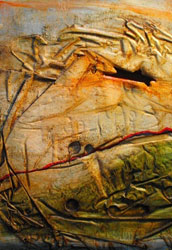Madhur Anand
Wild Blueberries
Green, ripe or shrunken
all on one branch. What is lowbush
law? A map, perhaps, that relates
past, present or future
with a kind of light
or just light’s kindness. The niceness
of nectar measured in precise
wavelengths of a bumblebee’s
flightiness or by a bear’s exposure
to height. The slightly acidic hills
exhaling to fruition tiny crowned spheres,
underground geometry. From one point
of view, it’s all the same: a social
network of pollen, rhizomes
or antioxidants. How does what’s beneath
the surface become second nature? Thin red juice
is clear but in a sense wrong. Those berries
being false accessory fruit in which sweet
flesh does not arise from ovaries, but from the
surface of petals. Alas, we’ve forgotten
the predicative power of petals. We want
to know more but before we do
the questions themselves end up steeped
in high tea or deeply embedded in someone’s breakfast
muffin. Still, there’s hope; come July and ripe
for the taking, wild blue is once again
the darkest blue. The blue of Van Gogh’s
‘Starry Night’ or ‘Café at Arles’. And we can stare
as long as we like through extended
museum hours or long summer days
and only manage to extract
this: part mystery, part fact.
You’ve seen its flowers, haven’t you?
Pale white lampshades
designed to keep
all the good light in.
Irises at Night
Irises bought for six-fifty a bunch
are framed by a triangular glass vase
on the dining room table.
A couple of tumblers’ worth
of standing water –
a long forgotten wetland.
In southern Europe, rhizomes
of Iris germanica, Iris florentina and Iris pallida
are dried to make orris root.
But connections are severed,
relationships suffer.
The scent of the root
is not the scent of its flower.
The price of the root
is not the price of its flower.
The name of the root
is not the name of its flower.
My infant son reaches
for purple and yellow.
But it’s the hard fibrous roots
he must chew to relieve the pain
of cutting teeth.
Someday he’ll become aware
that Bombay Sapphire tastes a bit
like violets. That will be his first lesson
in taxonomy.
Because it’ll just be the same
Liliaceae turning up
in the most unexpected places
to soothe us.
New conversations around a centerpiece
become variations around a theme:
history of the fleur-de-lis, recipe for Ras el hanout,
Van Gogh’s recovery, the lingering scent
of two dabs of Vol de Nuit.
Floral Formula
The lily is showing off
an even number of petals and sepals
oddly-shaped stigma, style
and a new design:
ovules in an inferior position
Get a good look at her whorl
what a clever set up
six stamens to three carpals
intercourse of fusion
with confusion
Offering up her sweetness
in bits, intent on making visitors
out of visitors
Oh yes, she knows perfectly well
how to put on a good sex show:
to end with ‘he loves me’
you have to start with ‘he loves me not’
Three Memories of Paris
i) Sycamores
draped in green, white and tan
colours that never go out of style
they stand guard over common gardens
and stately boulevards
leaves, the changing light
the unmistakable pattern
of camouflage
ii) Meeting you in the Tuileries
cool in my new chiffon dress
cream with big bright flowers across
my hips and breasts
and over my shoulders the thinnest
of spaghetti straps
and then not so much
as a phone call or bonjour
when we’re both back in Sudbury
and the dress has shrunk in spite of Zero
a phallic mushroom with all its parts labeled
push-pinned to your office wall: my postcard
from the Vienna botanical museum
iii) Softness
baguette and camembert from the rue Mouffetard
we take them back to the petite auberge
with the yellow brick walls
all morning use nothing more
than our hands and our mouths
Cellulose and Pigment
a yellow-covered poetry book
left by lazy summer days
in the green garden of the uncut
is buried
under two feet of snow
yellow is just a cover
for the unraked poems within
the loss of chlorophyll
litter left in place
the book will resurface
come Spring
with a fresh record
of wet, dry and frozen
encoded in the curves
of its pages
and as long as there are leaves
poems will rewrite themselves
elliptic, lobed, fine-toothed,
the margin, a turning point
for light



